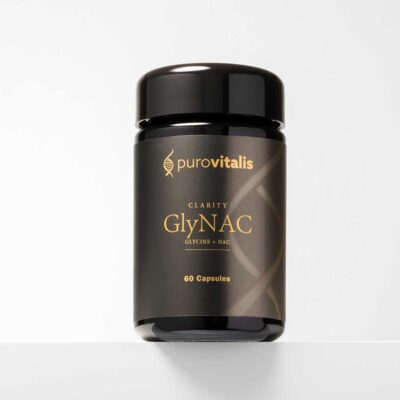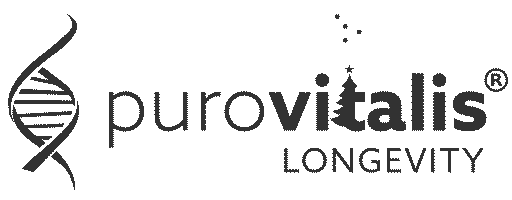
table of contents
The global population is aging rapidly. By 2050, more than 20% of people worldwide will be over the age of 60.
WHO, 2024
This shift brings clear challenges for health systems – but it also highlights something more fundamental: the importance of maintaining health, not just extending life.
Healthy longevity isn’t achieved late in life. It’s shaped over decades – by environment, habits, and the small biological processes that keep our cells functioning over time. Understanding and supporting those processes is becoming one of the most relevant health priorities of our time.
The study
A double-blind, placebo-controlled RCT from 2022 investigated whether it’s possible to influence these biological changes through supplementation with GlyNAC – a combination of two amino acids: glycine and N-acetylcysteine.
The improvements were remarkable. After just 16 weeks of GlyNAC supplementation, older participants showed measurable progress in 7 out of 9 recognized hallmarks of aging — read on to find out what GlyNAC does in the body – and why this combination may be uniquely suited to support healthy aging.
Hallmarks of Aging
The hallmarks of aging are a set of key biological processes that contribute to the gradual decline in function and increase in disease risk as we get older. Scientists have identified nine original hallmarks, each of which drives aging when it becomes unbalanced or damaged ⟶ read this.
Who took part in the study?
The study involved both older and younger adults to investigate the effects of GlyNAC at different life stages. All participants were examined at baseline, after 2 weeks, and after 16 weeks of supplementation.
Group overview:
| Group | Age range | BMI | Participants | Supplement | Duration |
|---|---|---|---|---|---|
| OAG | 61–80 years | >27 | 12 | GlyNAC | 16 weeks |
| OAP | 61–80 years | >27 | 12 | Alanine placebo | 16 weeks |
| YA | 21–40 years | <27 | 12 | GlyNAC | 2 weeks |
This setup allowed researchers to:
- Compare the effects of GlyNAC to placebo
- See how the older adults’ values changed compared to younger reference values
- Investigate whether GlyNAC provides any benefit to already healthy young adults
What did the study measure?
To understand how GlyNAC works, the researchers looked at how aging affects the body on multiple levels – from energy production to inflammation and cell repair. Here’s what they tested:
| What was measured | What it shows |
|---|---|
| Glutathione levels | The body’s main antioxidant and defense system |
| Oxidative stress | Damage from free radicals that accumulates with age |
| Mitochondrial function | How well cells produce energy and regulate fat and sugar |
| Inflammatory markers | Signs of low-grade chronic inflammation |
| Insulin sensitivity | How effectively the body regulates blood sugar |
| DNA damage & repair | The body’s ability to repair genetic damage |
| Autophagy & mitophagy | Internal cleanup processes that remove damaged cell parts |
| Muscle stem cell activity | The body’s potential to regenerate muscle tissue |
| Senescent cells | Aged, non-functioning cells that accumulate with age |
| Physical performance | Strength, walking speed, and endurance |
| Body composition | Fat distribution and waist circumference |
| Blood pressure | Indicator of cardiovascular health |
| Liver & kidney function | Safety markers to ensure the intervention doesn’t cause harm |
The results
Glutathione and oxidative stress
Older participants had much lower glutathione levels in both muscle and blood compared to younger adults. GlyNAC restored these levels to normal. The placebo group showed no changes.This was accompanied by a more than 70% reduction in oxidative stress markers, suggesting that GlyNAC doesn’t just supply antioxidants – it helps the body produce its own.
| Group | Muscle GSH<br>(mmol/kg) | Total GSH in Blood<br>(mmol/L) | Reduced GSH in Blood<br>(mmol/L) | GSH/GSSG Ratio |
|---|---|---|---|---|
| YA-0w (Young Adults) | 7.0 | 1.4 | 1.4 | 24.6 |
| OAG-0w (Older Adults, Before GlyNAC) | 2.4 ↓66% | 0.4 ↓70% | 0.4 ↓73% | 7.5 ↓70% |
| OAG-2w (After 2 Weeks GlyNAC) | 5.3 ↑121% | 1.2 ↑173% | 1.1 ↑195% | 14.7 ↑96% |
| OAG-16w (After 16 Weeks GlyNAC) | 6.3 ↑164% | 1.4 ↑225% | 1.3 ↑259% | 27.6 (normalized) |
| OAP-0w/16w (Older Adults, Placebo) | 2.4 → 2.4 (no change) | 0.5 → 0.5 (no change) | 0.4 → 0.4 (no change) | 9.0 → 9.5 (no change) |
Summary
After 16 weeks of GlyNAC supplementation, the older participants reached glutathione levels that were no longer different from those of the young adults. They went from a significant deficiency in the body’s most important antioxidant to normalized levels, both in muscle tissue and red blood cells.
Mitochondrial function
Mitochondria are often called the “powerhouses” of the cell because they turn food into energy. With age, they tend to burn less fat and rely more on sugar, which is less efficient. In this study, older adults had reduced fat burning and excessive glucose use.
⟶ After GlyNAC, fat oxidation improved by 78% and glucose reliance fell by 65%. This shift matters because it means cells can produce energy more efficiently, which can impact everything from stamina to brain function.
Chronic inflammation
Low-grade chronic inflammation increases with age and is linked to heart disease, diabetes, Alzheimer’s, and more. Older adults in the study had inflammatory markers like IL-6 up to 820% higher than in young adults.
⟶ GlyNAC lowered IL-6 by 78%, TNF-α by 54%, and CRP by 41%. This suggests it helped the immune system move from a constant “alarm” state to a healthier, balanced state.
Insulin and energy use
Insulin resistance means cells don’t respond well to insulin, making it harder for the body to control blood sugar. It can lead to fatigue, weight gain, and an increased risk of type 2 diabetes. Older adults in the study had insulin resistance more than four times higher than young adults.
⟶ With GlyNAC, insulin resistance dropped by 64% and fasting insulin levels fell by 65%, showing much better blood sugar control and metabolic health.
DNA Damage and cellular cleanup
DNA damage builds up with age and is linked to diseases and cellular decline.
⟶ GlyNAC reduced markers of DNA damage by 73% and improved the body’s ability to clear out old or damaged cell parts and mitochondria. In other words: signs of active cellular repair.
Physical function and body composition
Aging often brings slower walking speeds, weaker grip, and reduced stamina. These aren’t just lab measures – they directly affect independence and quality of life.
⟶ After GlyNAC, older adults walked faster, had stronger grip strength, and improved endurance in the 6-minute walk test. In some cases, their performance approached that of young adults.
| Measure | YA-0w | OAG-0w | OAG-16w | OAP-0w | OAP-16w |
|---|---|---|---|---|---|
| Gait speed (m/s) | 1.36 | 1.13 | 1.34 | 1.11 | 1.16 |
| Grip strength – dominant (kg) | 34.8 | 32.3 | 36.7 | 31.4 | 29.3 |
| Grip strength – non-dominant (kg) | 31.7 | 29.6 | 33.9 | 30.7 | 27.8 |
| Chair-rise (sec) | 16.5 | 25.6 | 18.8 | 22.6 | 20.7 |
| Six-minute walk (m) | 635 | 522 | 565 | 518 | 527 |
Blood pressure
Systolic blood pressure is the pressure in the arteries when the heart contracts, and it often rises with age. Higher values increase the risk of heart disease and stroke.
⟶ GlyNAC lowered systolic blood pressure in older adults, suggesting improved cardiovascular health.
| Measure | YA-0w | OAG-0w | OAG-16w | OAP-0w | OAP-16w |
|---|---|---|---|---|---|
| Systolic BP (mmHg) | 110.8 | 132.0 | 124.4 | 129.5 | 127.6 |
| Diastolic BP (mmHg) | 70.0 | 79.2 | 75.9 | 78.1 | 75.8 |
Why GlyNAC works – and why NAC alone doesn’t
According to the study, GlyNAC works because it provides the body with the essential building blocks needed to produce glutathione – the antioxidant that cells depend on to stay healthy. The researchers describe this as:
GlyNAC = The “Power of 3”
Glycine – amino acid needed to make glutathione and support DNA repair.
NAC – provides cysteine, essential for energy production and detoxification.
Glutathione – the body’s “master antioxidant,” protecting cells, supporting mitochondria, and neutralizing harmful oxidative stress.
With both glycine and cysteine available, the body can efficiently produce glutathione, combining all three for greater impact on cellular health and healthy aging.
This combination is what makes the difference.
The study notes that trials using NAC alone or pre-made glutathione often show little or no improvement. In some animal studies, NAC alone even worsened oxidative stress. The conclusion from the researchers is that the body needs the right components in the right balance – not just one of them. stress. The body needs the right pieces in the right balance – not just one of them.
Is GlyNAC safe?
Yes. No adverse effects were reported during the study. Liver and kidney markers remained stable. GlyNAC is made from natural amino acids the body already uses – it’s just delivered in the right amount and combination to support aging from the inside.
Healthy aging with GlyNAC
The world’s population is aging rapidly — by 2050, more than 20% of people will be over 60 (WHO, 2024). This makes healthy longevity one of the most important goals of our time, and it starts with protecting the biological systems that keep us strong, active, and resilient.
The clinical GlyNAC trial showed that combining glycine and NAC — known by researchers as the “Power of 3” when paired with the glutathione they help produce — can restore glutathione levels, reduce oxidative stress, improve mitochondrial energy, and support vital repair processes. In fact, the study found improvements in 7 out of 9 recognized hallmarks of aging.
Purovitalis GlyNAC delivers vegan, sugar-free capsule — 300 mg pure L-glycine and 300 mg NAC — produced in the EU under strict GMP standards and third-party tested for quality. Backed by science, it’s designed to fuel your cells, support recovery, and help you invest in your own longevity – from the inside out.
Curious how GlyNAC might support your healthy aging journey? Learn more about our GlyNAC supplement here:
- GlyNAC and sleep improvement
- GlyNAC for cognitive and mental health
- Best food sources of L-Cysteine for NAC production
References
- World Health Organization. Ageing and health [Internet]. Geneva: World Health Organization; 2024 Oct 1 [cited 2025 Aug 5]. Available from: https://www.who.int/news-room/fact-sheets/detail/ageing-and-health
- Kumar P, Liu C, Suliburk J, Hsu JW, Muthupillai R, Jahoor F, Minard CG, Taffet GE, Sekhar RV. Supplementing Glycine and N-Acetylcysteine (GlyNAC) in older adults improves glutathione deficiency, oxidative stress, mitochondrial dysfunction, inflammation, physical function, and aging hallmarks: a randomized clinical trial. J Gerontol A Biol Sci Med Sci. 2023;78(1):75–89. doi:10.1093/gerona/glac135

GlyNAC – Powerful Cellular Synergy Support glutathione production Fuel cellular energy
Experience the proven synergy of Glycine and N-Acetyl-Cysteïne. Together, they work more effectively than alone to restore glutathione levels, enhance mitochondrial function, and reduce oxidative stress.

Track 50+ health metrics with AI-powered accuracy. Start your free trial today and take control of your wellness journey!













